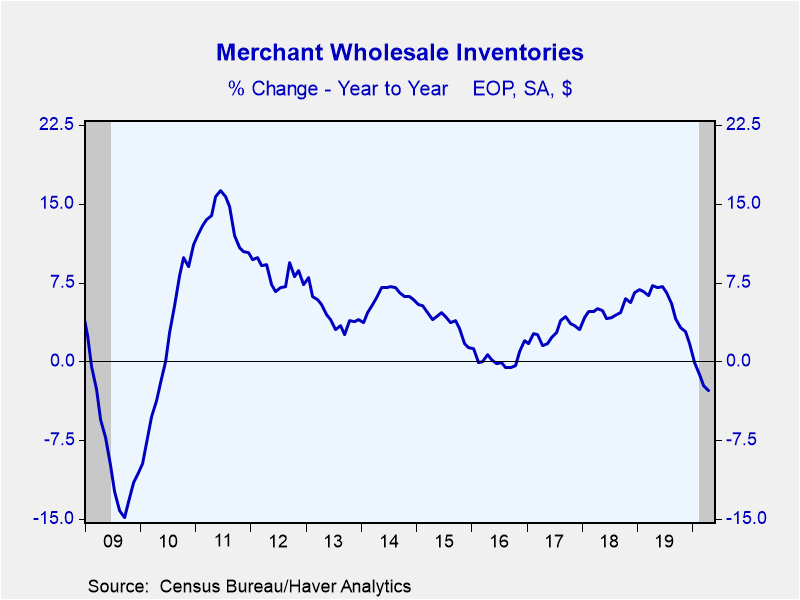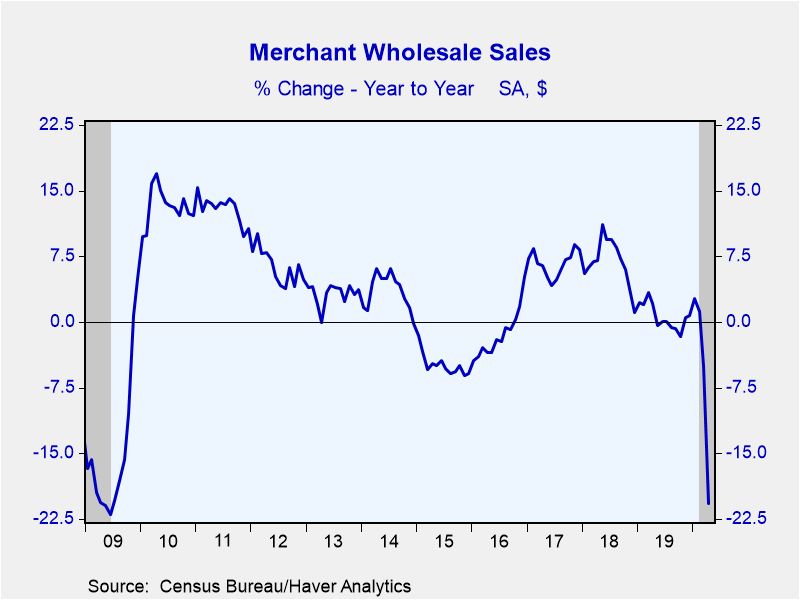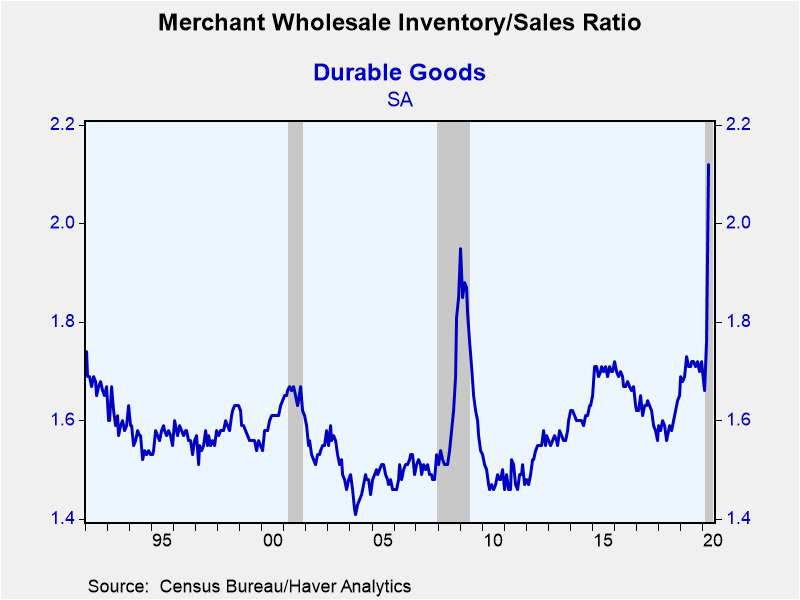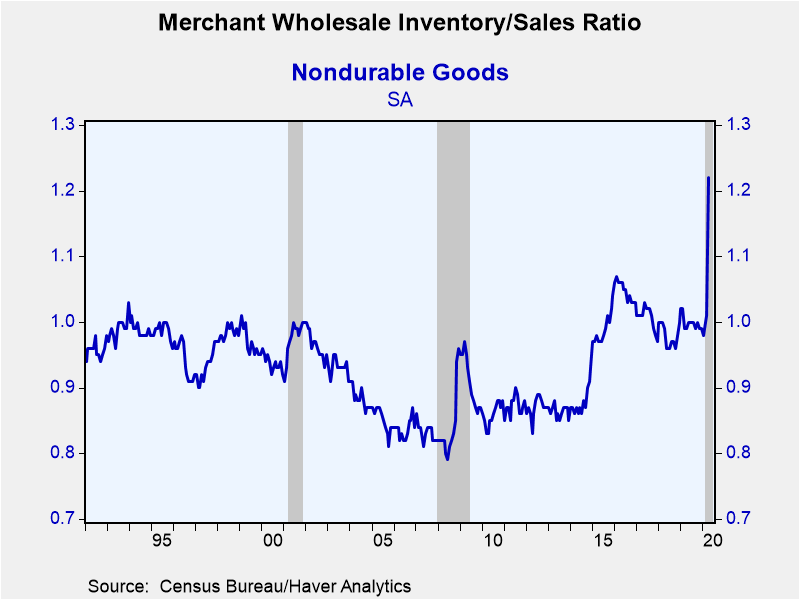 Global| Jun 09 2020
Global| Jun 09 2020Wholesale I/S Ratio Jumps to Record as Inventories Edge Up and Sales Plummet
Summary
• Wholesale inventory-to-sales ratio jumps to record 1.65 in April. • Inventories increased 0.3% while sales dropped 16.9%. • While inventory swings can have a meaningful impact on GDP, in the current quarter they will be overwhelmed [...]
• Wholesale inventory-to-sales ratio jumps to record 1.65 in April.
• Inventories increased 0.3% while sales dropped 16.9%.
• While inventory swings can have a meaningful impact on GDP, in the current quarter they will be overwhelmed by shifts in demand.
Wholesale inventories edged up 0.3% in April (-2.8% year-over-year) after three consecutive monthly declines. The Informa Global Markets Survey anticipated a 0.4% contraction. Wholesale inventory swings can have a meaningful impact on GDP. In the latest GDP report, first quarter inventories provided a 1.43 percentage point drag on GDP growth, revised down from previous 0.53 ppt estimate. In the current quarter any inventory swings will be overwhelmed by shifts in the final sales components such as consumption and investment.
The 0.3% decrease in durable goods inventories (-3.0% y/y) was more than offset by a 1.1% increase in nondurable goods (-2.5% y/y). Automotive inventories fell 2.8% (-3.6%) as the near halt in production – auto output fell 71.7% in April – was even larger than the fall-off in sales (-38.4% m/m; -45.9% y/y). Drug inventories, which make up over a quarter of nondurable inventories, jumped 6.0% (7.0% y/y). Groceries, the second largest category, declined 3.3% (+0.7% y/y).
Wholesale sales plummeted a greater-than-expected 16.9% during April (-20.7% y/y) after falling 5.1% in March. The Action Economics Forecast Survey anticipated a 10.3% fall. Durable goods sales dived 17.3% (-20.9% y/y) driven by the brake in autos discussed above. Nondurable wholesales dropped 16.5% (-20.5%) as petroleum products collapsed 35.3% (-54.3% y/y) likely the result of falling oil prices. Last month’s somewhat surprising decline in grocery wholesale sales accelerated to -11.4% in April (-11.2% y/y). This suggests the drop in restaurant wholesale demand was larger than the increase coming from consumer stores.
The inventory-to-sales (I/S) ratio at the wholesale level jumped to a record high of 1.65 in April (data goes back to 1980). Both the durable goods and non-durables I/S ratios notched records (2.12 and 1.22 respectively); these series go back to 1992.
The wholesale trade figures, industrial production and oil prices are available in Haver's USECON database. The expectations figure for inventories is contained in the MMSAMER database. Expectations for sales are in the AS1REPNA database.
| Wholesale Sector - NAICS Classification (%) | Apr | Mar | Feb | Apr Y/Y | 2019 | 2018 | 2017 |
|---|---|---|---|---|---|---|---|
| Inventories | 0.3 | -1.1 | -0.7 | -2.8 | 1.7 | 6.5 | 3.0 |
| Sales | -16.9 | -5.1 | -0.7 | -20.7 | 0.6 | 6.8 | 6.7 |
| I/S Ratio | 1.65 | 1.36 | 1.31 | 1.34 (Apr '19) | 1.34 | 1.28 | 1.30 |
Gerald D. Cohen
AuthorMore in Author Profile »Gerald Cohen provides strategic vision and leadership of the translational economic research and policy initiatives at the Kenan Institute of Private Enterprise.
He has worked in both the public and private sectors focusing on the intersection between financial markets and economic fundamentals. He was a Senior Economist at Haver Analytics from January 2019 to February 2021. During the Obama Administration Gerald was Deputy Assistant Secretary for Macroeconomic Analysis at the U.S. Department of Treasury where he helped formulate and evaluate the impact of policy proposals on the U.S. economy. Prior to Treasury, he co-managed a global macro fund at Ziff Brothers Investments.
Gerald holds a bachelor’s of science from the Massachusetts Institute of Technology and a Ph.D. in Economics from Harvard University and is a contributing author to 30-Second Money as well as a co-author of Political Cycles and the Macroeconomy.









